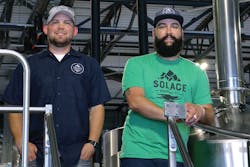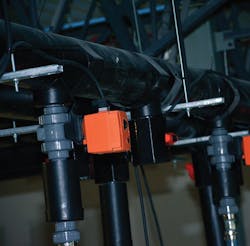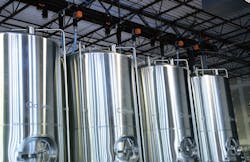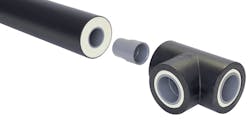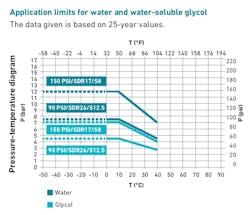Above: Owners of Solace Brewing Company, Drew Wiles (left) and Joh Humerick (right). (Photo courtesy of Joshua Hoffman, Bright Brain Media)
When business partners Drew Wiles and Jon Humerick first planned to build their own brewery in Virginia, they knew before breaking ground that they would install pre-insulated plastic pipe and fittings for their glycol loop. The decision was based not only from the pair’s prior experience working at a brewery and touring other facilities, but also from Wiles’ background at his family’s winery.
With a degree and experience in business administration, Humerick started working at Beltway Brewing Company after he went there as a potential customer. “I was doing the business planning for my own brewery and I wanted to hire Beltway Brewing to make beer for it,” Humerick said. “I quickly realized that to be successful in such a rapidly growing and changing industry, I needed to have experience. So, I took an opportunity to work there and that’s where I met Drew.”
Wiles completed studies in microbiology in college, and then moved back home and helped his mother and brother start a winery. “It was really almost out of necessity,” he said. “Our family inherited a piece of farmland and instead of parceling it off, selling it and losing the family farm, we created a workable family business with the opening of Paradise Springs Winery in 2008.” With his biology background, Wiles liked to hang out with the winemakers in the fermentation cellar on the production side of things. After about four years of making wine at the winery, he started making wine at home and then brewing beer. People were asking when he was going to start a brewery.
“Everyone thinks that a winery and a brewery are similar industries, but in reality, they are completely different,” said Wiles. “From production to packaging, serving and then to distribution, if you want to be successful, you have to know the ins and outs of both. When I did decide that’s the direction I wanted to take, I knew I would have to learn the business.”
To do that, Wiles went to work for Beltway Brewery as quality assurance/quality control manager of fermentation. After about a year and a half, he became production manager overseeing all production, packaging and warehousing. “The goal was always to start my own brewery,” said Wiles, “so finding a partner like Jon at Beltway to accomplish that, was exactly what I needed to get going on building a facility.”
Solace Brewing Company uses this pre-insulated plastic piping system for its glycol loops. (Image Courtesy of Joshua Hoffman, Bright Brain Media)
Wiles and Humerick learned about GF Piping Systems’ COOL-FIT ABS Plus pre-insulated plastic piping system for secondary cooling from touring numerous breweries but also from experience with Wiles’ family winery. (ABS pipe and fittings are made from a thermoplastic resin called Acrylonitrile-Butadiene-Styrene, ABS for short.)
“At Paradise, we had initially installed insulated PVC and learned the drawbacks there – you could see mold growing and there were leaks. It definitely wasn’t aesthetic or sanitary,” Wiles said. Because of these issues, the winery upgraded to this unique system during the time Wiles and Humerick were working at Beltway Brewing. “By that time, we knew all about this pre-insulated ABS piping for secondary cooling and that it was really the best choice.”
This ready-to-install system is a corrosion-free, pre-insulated ABS piping with a lifespan of 25 years. The system’s core pipe can convey cold fluids down to -50°F, and it is insulated with high-density, closed-cell polyurethane foam and protected with a watertight, ultraviolet (UV)-resistant black polyethylene jacket. The entire system is vapor-tight and shows no thermal bridges, which minimizes energy loss along the lines.
The ABS piping system includes 250 feet of 4-inch (d110) headers with 11/2-inch (d50) drops to each of the five fermentation tanks, plus full-port, electric-actuated ball valves on the supply piping to the tanks and manual full-port ball valves on the return lines. (Image courtesy of GF Piping Systems.)
To save on expenses, Wiles and Humerick installed the entire piping system themselves, including drops for future expansion. Because of their experience at Beltway Brewing, the partners had learned the importance of proper installation and spent a lot of time in the business planning stage on engineering. The general contractor for the Solace build was a certified installer for this piping, and Wiles and Humerick were able to go over best-install practices before they started putting everything together.
Solace Brewing encompasses 15,766 square feet that includes the production area and tasting room. The current piping system consists of 250 feet of 4-inch (d110) headers with 11/2-inch (d50) drops to each of the five fermentation tanks. Full-port, electric-actuated ball valves are placed on the supply line to the tanks and manual full-port ball valves on the return lines. The system conveys cold glycol to supply and maintain proper fermentation and cellaring temperatures from 50 to 75°F, depending on beer style. The system is also used to cold condition the beer after fermentation and for packaging brite beer around 32°F. During the piping installation, the owners plumbed in valves for eight tanks, allowing for future expansion. Equipment that came with the brewing system from Craftwerk Brewing Systems included a three-vessel brew house, four 40-barrel (bbl) fermenters, and one 40-bbl brite beer tank.
A typical design for temperature control of beer production using ABS pre-insulated plastic piping, fittings and valves. The system maintains proper cooling for hop storage, wort, fermentation filtration, filling line and beer storage. (Image courtesy of GF Piping Systems.)
“The support from the piping system manufacturer’s representative was fantastic,” said Wiles. “I planned out our loop for size and proper floating so that the first tank on the supply is the last on the return line – that helps balance the whole system. Beyond that, I showed them our plant layout, the loop and explained our vision for future expansion. They put together a full list of all the sleeves, nipples, adaptor pieces, amount of piping and valves we would need.” A local distributor in Richmond supplied the system and was quick to send replacement pieces or extra pieces as needed to finish the job.
“With this pre-insulated piping system, you install it once and that’s it,” Wiles said. “You don’t need to go back later and keep making repairs. We paid attention to detail on each cemented connection – every adaptor nipple, barrel nipple, every connection to every fitting and piece of pipe. It was a little crazy with just the two of us and the install took two full weeks, but now we have an installation that will last us forever. It’s going to stay that way for 10 or 20 years – however long the brewery is in operation.”
The corrosion-free, pre-insulated ABS piping system is specifically designed to meet the requirements of secondary cooling loops in food and beverage production facilities as well as any others where efficient cooling is required. The three-in-one system incorporates: 1) a low-temperature ABS carrier piping system, 2) PUR (polyurethane foam) insulation, and 3) a UV-resistant, black high-density polyethylene jacket. The entire system is vapor-tight and shows no thermal bridges, which minimizes energy loss along the lines. (Image courtesy of GF Piping Systems).
Initial beer production at Solace is anticipated to be about 3,600 barrels a year. When the additional eight tanks are brought in at some point in the future, production is expected to top 15,000 barrels per year. Wiles and Humerick plan to produce a variety of craft beers with many IPAs and different styles along with some special flagship beers. They also plan to have a barrel-aging program, using winery barrels and whiskey barrels through the connections they’ve developed over the years.
Wiles especially likes their decision to use 4-inch (d110) headers as well as the flexibility the system allowed for future growth. “We can easily expand as needed. If we want to chill our cold box, we could do a glycol air heat exchanger and chill it that way. We can also expand the header to future parts of our brewery floor to add even more tanks when necessary.”
Angela Sampaio has worked for GF Piping Systems since March 2006 and is currently the market segment manager Cooling for the Eastern United States. Prior to her career at GF Piping Systems, she worked for eight years as market development manager for an international manufacturer of plastic piping systems for municipal infrastructure, namely potable water, gas and sewage applications. Sampaio can be reached at angela. [email protected] or 786-857-6249.
